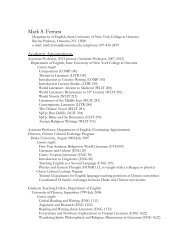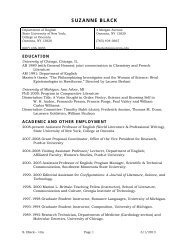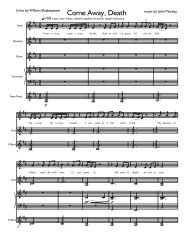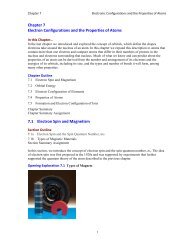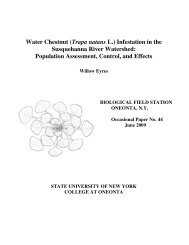quantitative analyses of periphyton biomass and ... - SUNY Oneonta
quantitative analyses of periphyton biomass and ... - SUNY Oneonta
quantitative analyses of periphyton biomass and ... - SUNY Oneonta
You also want an ePaper? Increase the reach of your titles
YUMPU automatically turns print PDFs into web optimized ePapers that Google loves.
overall seasonal average <strong>of</strong> T-P0 4 was approximately 2.5 times greater in the<br />
urban stream (.256 mg/I) than in the agricultural (.057 mg/I) or forested streams<br />
(.035 mg/I). The highest seasonal averages <strong>of</strong> N0 3 were during winter in the<br />
agricultural streams (1.96 mg/I) <strong>and</strong> in the forested streams the same N0 3<br />
average was measured during summer, winter, <strong>and</strong> spring (.54 mg/I). In the<br />
urban stream, the highest seasonal average <strong>of</strong> N0 3 was during summer (.49<br />
mg/I). The lowest seasonal averages <strong>of</strong> N0 3 were during summer in the<br />
agricultural streams (.70 mg/I) <strong>and</strong> during fall in the forested streams (.21 mg/I)<br />
<strong>and</strong> the urban stream (.24 mg/I). The overall seasonal average <strong>of</strong> N0 3 was<br />
highest in the agricultural streams (1.22 mg/I) which was 2.5 times greater than<br />
the value in the forested streams (.46 mg/I) <strong>and</strong> the urban stream (.35 mg/I).<br />
Table 3c shows that the highest seasonal average <strong>of</strong> CI in the<br />
agricultural (10.69 mg/l) <strong>and</strong> forested streams (8.06 mg/I) occur-red in fall. In the<br />
urban stream, the highest seasonal average <strong>of</strong> CI occurred in winter (87.71<br />
mg/I). The lowest seasonal averages <strong>of</strong> CI occurred in spring for all the<br />
characterized streams; agricultural 5.69 mg/I, forested 4.76 mg/I, <strong>and</strong> urban<br />
16.91 mg/1. The overall seasonal average <strong>of</strong> CI in the urban stream (38.82 mg/I)<br />
was approximately five times greater than the overall seasonal average <strong>of</strong> CI in<br />
the agricultural (7.77 mg/I) <strong>and</strong> forested streams (6.27 mg/I). Seasonal turbidity<br />
averages in the agricultural streams (20.87 ntu), forested streams (21.43 ntu),<br />
<strong>and</strong> the urban stream (815.10 ntu) were highest during summer <strong>and</strong> lowest<br />
during the fall (9.92 ntu, 2.49 ntu, <strong>and</strong> 78.82 ntu, respectively). The overall<br />
seasonal average <strong>of</strong> TRB in the urban stream (306.09 ntu) was approximately<br />
20 times greater than the overall seasonal averages in the agricultural (15.58<br />
29



